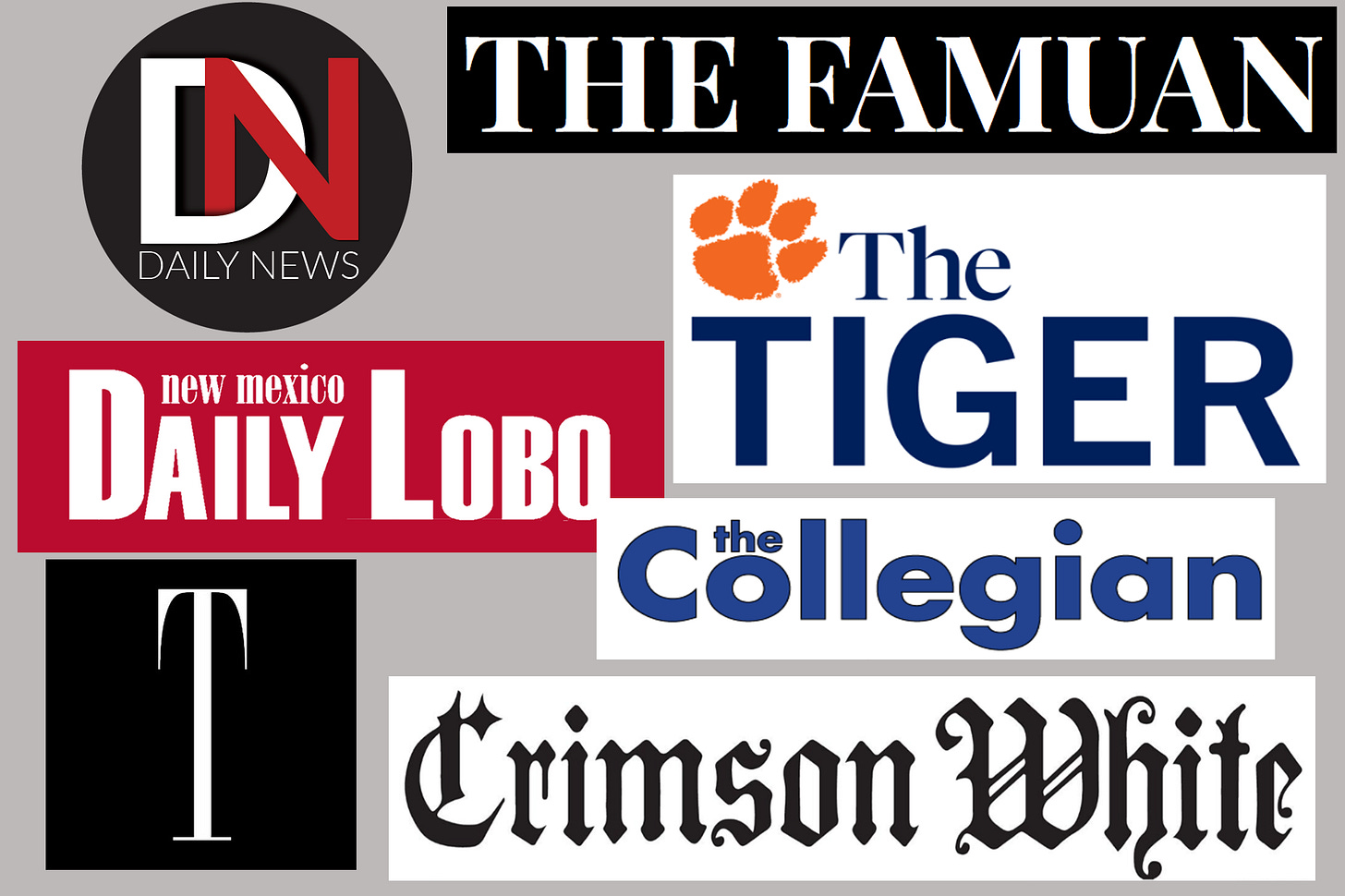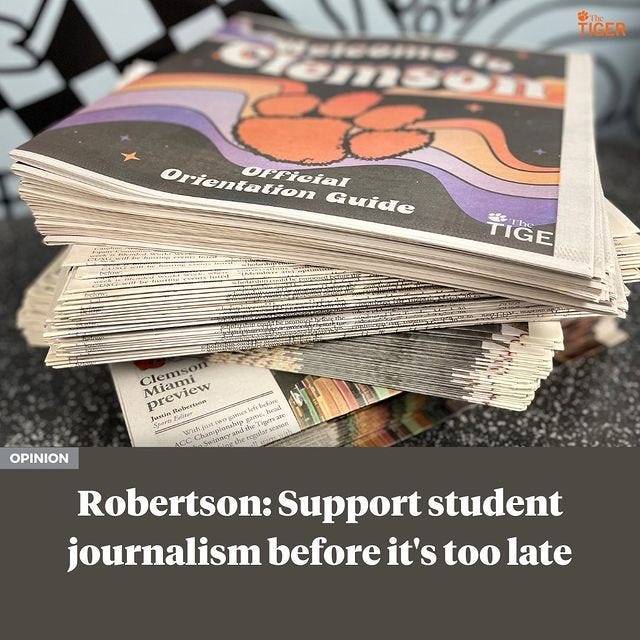Seven lesser-known student newspapers making impact in 2023
FOIA requests. Student government drama. Community reporting.

To student journalists: Keep doing what you’re doing.
Amid an existential crisis in the local news industry, student journalists are bridging the gap, reporting on their respective communities and governmental affairs beyond the confines of their college campuses.
The ex-Stanford University president resigned due to academic misconduct exposed by The Stanford Daily. The Yale Daily News' coverage prompted a federal lawsuit and policy changes on mental health leave. The Daily Northwestern's report on alleged hazing got the university's football coach fired.
In almost every instance, they're doing it for free without any recognition — all while juggling the demands of their academic responsibilities.
As the end of 2023 approaches, I wanted to highlight some of the impactful student journalism produced by lesser-known student newspapers.
From holding their student governments accountable to using public records to tell a story of hazing practices within a fraternity and calling out their university for noncompliance with crime reporting laws, here’s a glimpse into the work of seven newspapers across the country.
The Crimson White — University of Alabama
If someone’s taking student government seriously, it’s the student journalists at the University of Alabama. In a recent election cycle marked by allegations of fraud, these journalists produced a series of at least seven articles delving into the controversy.
What sets their reporting apart is their approach to information sourcing and verification. From official election complaints to unconventional sources like YikYak messages and Instagram stories, they left no stone unturned.
Their investigation raised questions about the fairness and transparency of SGA elections, highlighting the surge in complaints from Greek students against independent candidates and the potential influence of The Machine, a “secret” organization at the university.
One particular story detailed an accusation against a senatorial candidate who allegedly created an anonymous Instagram account to "spread hate." Despite the candidate's denial, the newspaper went above and beyond, establishing a connection to the account by verifying the credibility of their anonymous tipster. This involved snooping through screenshots, conducting interviews with the candidate and campaign manager and employing other investigative tactics.
The CW confirmed the Instagram account in question was registered to the candidate's campaign manager, who was let go after publication. The candidate was also disqualified by the election board.
The Collegian — South Dakota State University
More student government drama.
The university’s student president was arrested and charged with a fictitious license and underage purchase or possession of alcoholic beverages. Undeterred, student reporters delved deeper into the story, uncovering that the president was also investigated for another vandalism incident.
Local TV stations quickly picked up the initial story, revealing that the student president had also been cited for underage consumption before that arrest.
The student president, who ran heavily on his opponent’s ethics violation complaint, contested the charges. He told the paper law enforcement had no valid reason to stop him, and regarding the fake ID charge, he claimed to be "just like every other college student."
Initially resistant to stepping down from his position, the president publicly apologized and resigned following publication, less than a month into his term.
The Daily News — Ball State University
An eight-month investigation into an Indiana property management company by a student journalist prompted a state attorney general probe, leading to a settlement and policy change.
The journalist analyzed the state tenant laws and public records and interviewed experts, property owners, tenants and elected officials.
The reporting shed light on a range of grievances against the company spanning from issues of excessive heat to untreated sewage, false promises and the imposition of deceptive redecoration fees in lieu of a security deposit.
The student journalist faced various challenges, including unresponsiveness from certain state representatives and the company's reluctance to address specific questions, according to the paper.
After the reports, the Homeowner Property Unit of the Indiana Attorney General's office stepped in to investigate. MiddleTown Property Groups agreed to pay $35,000 to settle the case.
Given the substantial number of Ball State students renting from the company, the university also released a “quality housing” list of off-campus rentals.
Technician — North Carolina State University
In the last academic year, the university saw 14 student deaths — seven of them attributed to suicide. I saw this number on ABC News, and my first thought was it must have been difficult for the student journalists to cover those.
While they kept death stories brief, their coverage extended beyond the initial reports, delving into crucial follow-up stories.
These included examinations of how the housing department and resident assistants coped with a “campus mental health crisis,” discussions on the nationwide trend of declining mental health among college students, guides on how to access mental health and counseling resources on campus and insights into school leaders’ responses to the deaths.
Back in 2022, The Technician called out the university for its perceived failure to “properly communicate” about recent campus deaths. The editorial board argued that the “display of ignorance and lack of transparency” did more harm than good, actively spreading misinformation within the campus community.
The editorial urged for a more comprehensive community alert system for future incidents, increased investment in mental health programs beyond superficial events like dog therapy, deemed as "cute and a great photo opportunity,” and a formal initiative for the university to officially track suicide deaths.
The Tiger — Clemson University
South Carolina student journalists, utilizing public records, uncovered hazing allegations at Clemson University's Alpha Gamma Rho chapter, resulting in a four-year suspension.
The Tiger reported on a complaint from AGR new members, detailing hazing incidents, including a "chemical burn," personal servitude and sleep deprivation, sourced from a letter obtained through a public records request.
The paper not only covered the allegations but also explained the investigative process and timeline.
After the university confirmed the chapter's guilt without much detail, The Tiger continued its reporting.
A month later, The Tiger revealed the incident — how a member poured ice and salt on a new member’s back — contributing to the suspension, based on an investigation report obtained through public records.
Kudos to the journalists and South Carolina's Tucker Hipps Transparency Act, which mandates universities to publicize Greek organizations' misconduct reports.
The Daily Lobo — University of New Mexico
Not every university is good when it comes to publicizing crimes as required by laws, however.
In Albuquerque, student reporters revealed a significant lapse in crime transparency. Their headline, “UNM is noncompliant with crime transparency law,” detailed how the university's crime reports failed to meet the legal requirements of the Clery Act.
While federal law mandates information about the nature, date, time, general location and case status, the university had only provided the nature and date, with a generic timestamp of "00:00:00" for every incident over at least a year.
Acknowledging the outdated system, UNM police admitted to the lapse and indicated ongoing efforts to update it, a move that’s now reflected in the updated daily crime log.
The article also shed light on the university's failure to issue timely warnings for specific crimes, a violation of legal requirements. Notably, during an incident last year involving reports of an active shooter (later deemed a false alarm), the campus community received no alert, according to the paper.
The Daily Lobo's coverage extended beyond these specific incidents, highlighting their overall commitment to accurate crime reporting.
They cautioned against relying solely on annual crime data released by authorities, emphasizing potential inaccuracies. And they didn’t rely on a police report as a sole source.
The Famuan — Florida A&M University
Student journalism, as exemplified by The Famuan at the Florida school, extends its impact beyond the campus, reaching into the broader Tallahassee community through their class, “SJGC Capital Bureau.”
The publication covers a range of significant local topics including a new death penalty expansion law, a legislative effort to address food deserts and the funding challenges faced by the Children’s Advocacy Center in the city.
Some of the stories produced by The Famuan aren't even found on local news sites, (according to my quick Google search that could be wrong), such as the coverage of the on-the-job harassment endured by first responders.
There’s a local angle to every story, as demonstrated by The Famuan’s reporting.
Examples include exploring the financial impact of the United Auto Workers strike on a Tallahassee Ford owner, capturing the reactions of local arts students to the Hollywood strike and examining the minimal impact of a new Florida law banning the use of public money for diversity, equity, and inclusion initiatives at the university.
The Famuan stands out for its dedication to bringing relevant and often overlooked local stories to the forefront, showcasing the valuable role of student journalism in community reporting.
Correction: The earlier version’s featured image included the wrong logo of The Ball State Daily News. It has been updated.
Note: I’m taking a publishing break for a week. The next story will run Monday, Jan. 8.
In 2024, The Nutgraf will focus more on producing stories for student journalists. Please subscribe, share this with your friends and stay tuned. Thank you for your support over the past few months. Happy holidays and Happy New Year!
End-of-year stories:
Rebirth of local journalism: Best work from news outlets across US — New York Times
A look back at the best and worst of the news media in 2023 — Poytner
PolitiFact’s 2023 ‘Lie of the Year’: RFK Jr.’s campaign of conspiracy theories — Poytner
College media remains the news industry’s younger, cooler aunt in 2024: Prediction — Nieman Lab
The war in Gaza is a big story on campus. These student reporters aren't shying away — NPR
‘Unparalleled’: Israel-Gaza war takes record toll on journalists — CPJ







